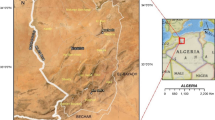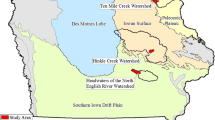Abstract
Three of DRASTIC’s parameters (Depth to Water, Soil Media, and Topography) were modified and another parameter was added (land use/land cover) to the model to determine the potential impact on groundwater from Confined Animal Feeding Operations (CAFO) manure lagoon settings and manure application as fertilizer. Williams County is a mostly agricultural county located in northwest Ohio, USA. It currently has three CAFOs, all dairy, with the possibility of the construction of a multi-million chicken egg CAFO in the near future. A Geographic Information System (GIS) was utilized to modify the Ohio Department of Natural Resources (ODNR) DRASTIC map for the county to fully assess the county-wide pollution potential of CAFOs. The CAFO DRASTIC map indicates that almost half of Williams County has elevated groundwater pollution potential. The rest of the county, primarily the southeast corner, has lower CAFO groundwater pollution potential. Future CAFO development within the county should focus on the southeastern portion of the county where the groundwater table is deeper, and the aquifer is composed of shale substrate with low hydraulic conductivity. The CAFO DRASTIC results are intended to be used as a screening tool and are not to replace site-specific hydrogeologic investigations.








Similar content being viewed by others
References
Al-Adamat RAN, Foster IDL, Baban SMJ (2003) Groundwater vulnerability and risk mapping for the Basaltic aquifer of the Azraq basin of Jordan using GIS, Remote Sensing and DRASTIC. Appl Geogr 23:303–324
Aller L, Bennett T, Lehr JH, Petty RJ, Hackett G (1987) DRASTIC: a standardized system for evaluating ground water pollution potential using hydrogeologic settings. U.S. Environmental Protection Agency EPA/600/2–87/035
Allison D (2006) Chickens on the way? The Bryan Times, Bryan, Ohio, USA 58(61), 14 March 2006
Angle MP, Ziss B, Bonifas C (2003) Ground water pollution potential of Williams County, Ohio. Ohio Department of Natural Resources, Division of Water, Water Resources Section, Report 60
Babiker IS, Mohamed AA, Hiyama T, Kato K (2005) A GIS-based DRASTIC model for assessing aquifer vulnerability in Kakamigahara Heights, Gifu Prefecture, central Japan. Sci Total Environ 345:127–140
Baggett SM (1987) Ground-water resources of the Bryan Area, Williams County, Ohio. Master’s Thesis, University of Toledo, Toledo, Ohio, USA
Bennett and Williams Environmental Consultants, Inc. (2002) Delineated Wellhead Protection Area for the City of Bryan Well Field. Report prepared for the City of Bryan Municipalities
Bryan Municipal Utilities (2006) Annual Report, City of Bryan, Ohio, USA
Campagnolo ER, Johnson KR, Karpati A, Rubin CS, Kolpin DW, Meyer MT, Esteban JE, Currier RW, Smith K, Thu KM, McGeehin M (2002) Antimicrobial residues in animal waste and water resources proximal to large-scale swine and poultry feeding operations. Sci Total Environ 299:89–95
Ceplecha ZL, Waskom RM, Bauder TA, Sharkoff JL, Khosla R (2004) Vulnerability assessments of Colorado ground water to nitrate concentration. Water Air Soil Pollut 159:373–394
Coen AW III (1989) Ground-water resources of Williams County, Ohio, 1984–1986. USGS, Water Resources Inv Report 89–4020
Davis AD, Long AJ, Wireman M (2002) KARSTIC: a sensitivity method for carbonate aquifers in karst terrain. Environ Geol 42(1):65–72
Dixon B (2005) Groundwater vulnerability mapping: a GIS and fuzzy rule based integrated tool. Appl Geogr 25:327–347
Ducci D (1999) GIS techniques for mapping groundwater contamination risk. Nat Hazards 20:279–294
Evans BM, Myers WL (1990) A GIS-based approach evaluating regional groundwater pollution potential with DRASTIC. J Soil Water Conserv 45:242–245
Fritch TG, McKnight CL, Yelderman JC, Dworkin SI, Arnold JG (2000) A predictive modeling approach to assessing the groundwater pollution susceptibility of the Paluxy Aquifer, Central Texas using a Geographic Information System. Environ Geol 39(9):1063–1069
Holman IP, Palmer RC, Bellamy PH, Hollis JM (2005) Validation of an intrinsic groundwater pollution vulnerability methodology using a national nitrate database. Hydrogeol J 13:665–674
Hoorman JJ, Shipitalo MJ (2006) Subsurface drainage and liquid manure. J Soil Water Conserv 61(3):94–94
King JM (1977) Ground-water resources of Williams County, Ohio. Master’s Thesis, University of Toledo, Toledo, Ohio, USA
Krapac IG, Dey WS, Roy WR, Smyth CA, Storments E, Sargent SL, Steele JD (2001) Impacts of swine manure pits on groundwater quality. Environ Pollut 120:475–492
Mancl K (1994) Water use planning guide. The Ohio State University Extension Fact Sheet, AEX-420–94
Naqa AE (2004) Aquifer vulnerability assessment using the DRASTIC model at Russeifa landfill, northeast Jordan. Environ Geol 43:51–62
Ohio Revised Code, Title IX, Section 903, Concentrated Animal Feeding Facilities. http://codes.ohio.gov/orc/903. Cited 10 May 2007
Panagopoulos GP, Antonakos AK, Lambrakis NJ (2006) Optimization of the DRASTIC method for groundwater vulnerability assessment via the use of simple statistical methods and GIS. Hydrogeol J 14:894–911
Randall J, Eastridge ML, Brown LC, Elder KH, Foster SS, Hoorman JJ, Joyce MJ, Keener HM, Mancl K, Monnin MJ, Rausch JN, Smith JM, Tuovinen O, Watson ME, Wicks MH, Widman N, Zhao LY (2006) Ohio livestock manure management guide. The Ohio State University Extension Bulletin 604–06
Ray JA, O’Dell PW (1993) DIVERSITY: a new method for evaluating sensitivity of groundwater to contamination. Environ Geol 22(4):345–352
Secunda S, Collin ML, Melloul AJ (1998) Groundwater vulnerability assessment using a composite model combining DRASTIC with extensive agricultural land use in Israel’s Sharon region. J Environ Manage 54:39–57
Shipitalo MJ, Gibbs F (2005) Preferential flow of liquid manure in macropores and cracks. The Society for Engineering in Agricultural, Food, and Biological Systems, Paper Number: 052063
Simpkins WW, Brukart MR, Helmke MF, Trenton NT, James DE, Jaquis RJ, Cole KJ (2002) Potential impact of earthen waste storage structures on water resources in Iowa. J Am Water Resour Assoc 38(3):759–771
Smith JE Jr, Perdek JM (2004) Assessment and management of watershed microbial contaminants. Crit Rev Environ Sci Technol 34(2):109–139
Thirumalaivasan D, Karmegam M, Venugopal K (2003) AHP-DRASTIC: software for specific aquifer vulnerability assessment using DRASTIC model and GIS. Environ Model Softw 18:645–656
U.S. Census Bureau (2003) 2000 Census of population and housing, population and housing unit counts PHC-3–37, Ohio. Washington, DC
Weatherington-Rice J, Christy AD, Angle MP, Aller L (2006) DRASTIC hydrogeologic settings modified for fractured till: Part 1 Theory. Ohio J Sci 106(2):45–50
Wilde FD, Britton LJ, Miller CV, Kolpin DW (2000) Effects of animal feeding operations on water resources and the environment. In: Proceedings of the technical emeting, Fort Collins, Colorado, 30 August–1 September 1999. U.S. Geological Survey, Open-File Report 00–204
Acknowledgments
We would like to thank Julie Weatherington-Rice of Bennett and Williams, and Mike Angle of the Ohio Department of Natural Resources, Division of Water for their comments and insights on this project. This study was a master’s thesis by Ryan Dickerson at Bowling Green State University.
Author information
Authors and Affiliations
Corresponding author
Rights and permissions
About this article
Cite this article
Gomezdelcampo, E., Dickerson, J.R. A modified DRASTIC model for Siting Confined Animal Feeding Operations in Williams County, Ohio, USA. Environ Geol 55, 1821–1832 (2008). https://doi.org/10.1007/s00254-007-1133-8
Received:
Accepted:
Published:
Issue Date:
DOI: https://doi.org/10.1007/s00254-007-1133-8




